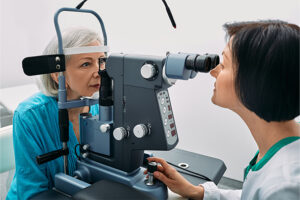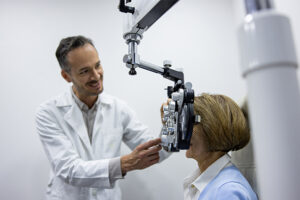Ophthalmology
Neovascular Age-Related Macular Degeneration and Diabetic Macular Edema
Treatment Challenges in Neovascular Age-Related Macular Degeneration and Diabetic Macular Edema
Whether considering neovascular age-related macular degeneration (nAMD) or diabetic macular edema (DME), individual patients can vary in their responses to anti-VEGF therapy. The definition of a suboptimal response to anti-VEGF therapy is not well defined, in part due to heterogeneity within the category.
Although anti-VEGF therapies are highly effective, some patients will demonstrate a suboptimal response to treatment. There is a lack of consensus on the definition of suboptimal response in these patients. This category includes patients who never get dry despite whatever treatment approaches are taken. Additionally, some patients will have a favorable response initially, but you will have to treat them very frequently, which increases the treatment burden.
The reasons for a suboptimal response to anti-VEGF therapy could be related to the involvement of multiple disease mechanisms. This is most clear in DME, where we know that there can be inflammatory mechanisms present, leading to the involvement of cytokines other than VEGF. In some patients, one pathway may be contributing more substantially to their DME than VEGF, which may explain their poor response to anti-VEGF therapy.
While this may also be true for patients with nAMD, another reason for a poor response to anti-VEGF therapy in those with nAMD may be the presence of concomitant disease(s) or simply a misdiagnosis. Some patients with suspected nAMD may have something called pachychoroid spectrum disease. This disease category is currently evolving, with some people referring to it as venous congestion or venous overload choroidopathy.
The bottom line is that there may be alternate mechanisms that contribute to choroidal venous congestion and insufficiency with an impact on retinal pigment epithelium pump function, resulting in the accumulation of fluid. This mechanism may not be amenable to anti-VEGF treatment and may be associated with the development of other vascular anomalies. Patients with these mechanisms may not respond well to anti-VEGF monotherapy and may require supplemental treatments, such as photodynamic therapy. It is important for physicians to consider these alternate mechanisms when making decisions about additional or adjunctive therapies for nAMD and DME.
There are also going to be subsets of patients with nAMD or DME who are a bit more advanced and in whom the mechanisms of fluid accumulation may already be degenerative. No amount of pharmacologic treatment may be sufficient to resolve these areas of cystoid degeneration. Of course, you want to make sure that you treat any treatable fluid, but you also need to be vigilant for these possibilities so that you do not perform treatment that will not benefit the patient. One of the things that I like to do, in terms of understanding whether the fluid is responsive to therapy or not, is to bring the patient back early after an injection. This can sometimes help us in distinguishing between degenerative fluid and fluid that may be associated with disease activity.
I agree on the potential value of having an early window of observation after treatment. In some of the trials of longer-duration treatments, one of the ways to screen patients and assess an initial response to therapy has been to treat them with an anti-VEGF therapy and bring them back within 1 week to look at the effect. When you assess the patient at an early time point post treatment, you get a better sense of how they are responding to the immediate suppression of VEGF. We are learning that there are some patients, particularly those with chronic disease, who just do not respond very well to the suppression of VEGFA alone.
I think that steroids and steroid implants, in general, have been given a bad rap, and one of the reasons for this is that they increase the risk of cataracts. This issue makes the clinical trials more challenging because if you include patients without previous cataract surgery, there may be some decrease in vision from the cataract. When you are using visual outcomes as your primary end point, unless you take issues such as this into account, it can complicate the outcome assessment and make it look like the steroids are not as effective.
Another issue is that, in many of these trials in which we are looking at previously treated patients with chronic disease, you may often see anatomic improvement with therapy without corresponding visual improvement. There may be better control of the edema, but, because the edema has been present for longer periods of time, the patient already has some damage, and it can be challenging to detect visual improvement. Overall, I do think that steroids are still a good second-line treatment option in patients with difficult-to-treat DME.
One of the effects of blocking angiopoietin 2 (Ang2) is blocking some of the inflammatory processes that may be occurring with disease. This may be an added benefit of combining VEGFA suppression with Ang2 suppression. These outcomes are still being evaluated, but the thought is that this combination may provide a longer duration of effects in patients with DME compared with monotherapy due to the addition of the anti-inflammatory component. Having said that, I think that steroids probably offer a greater anti-inflammatory component than Ang2 suppression. There are some patients in whom there is a significant inflammatory component, or multiple pathologic factors in addition to VEGF, where the addition of steroids seems to help.
This topic has been very well summarized, and I would simply reiterate that DME should be considered a multifactorial disease. For some patients with DME, just inhibiting VEGF, Ang2, or even PlGF is not enough to control the disease because additional pathways are at play. An important pathway to consider in these patients is the Tie2 pathway and its potential role in disease pathophysiology. Currently, we are beginning to use Ang2 inhibitors to prevent inactivation of the Tie2 pathway, and even direct Tie2 activation is something that is being tested for the future.
We also know that diabetes has a very large inflammatory component, which is one of the reasons why steroids work well in patients with DME. Steroids are not used first line because of their side effects, including the development of cataracts and increased intraocular pressure. When they are used in patients who do not respond to initial therapy, these individuals should be closely monitored for these complications.
Agard NJ, Zhang G, Ridgeway J, et al. Direct Tie2 agonists stabilize vasculature for the treatment of diabetic macular edema. Transl Vis Sci Technol. 2022;11(10):27. doi:10.1167/tvst.11.10.27
Akwii RG, Sajib MS, Zahra FT, Mikelis CM. Role of angiopoietin-2 in vascular physiology and pathophysiology. Cells. 2019;8(5):471. doi:10.3390/cells8050471
Brown DM, Boyer DS, Csaky K, et al; RUBY Investigators. Intravitreal nesvacumab (antiangiopoietin 2) plus aflibercept in diabetic macular edema: phase 2 RUBY randomized trial. Retina. 2022;42(6):1111-1120. doi:10.1097/IAE.0000000000003441
Hatamnejad A, Orr S, Dadak R, Khanani A, Singh R, Choudhry N. Anti-VEGF and steroid combination therapy relative to anti-VEGF mono therapy for the treatment of refractory DME: a systematic review of efficacy and meta-analysis of safety. Acta Ophthalmol. 2023 Jun 26. doi:10.1111/aos.15724
Hollaus M, Bühl W, Schmidt-Erfurth U, Sacu S. The challenges of treating neovascular age-related macular degeneration. Klin Monbl Augenheilkd. 2022;239(8):1033-1042. doi:10.1055/a-1473-5713
Kuroiwa DAK, Malerbi FK, Regatieri CVS. New insights in resistant diabetic macular edema. Ophthalmologica. 2021;244(6):485-494. doi:10.1159/000516614
Lombardo M, Serrao S, Lombardo G. Challenges in age-related macular degeneration: from risk factors to novel diagnostics and prevention strategies. Front Med (Lausanne). 2022;9:887104. doi:10.3389/fmed.2022.887104
Sam-Oyerinde OA, Patel PJ. Real-world outcomes of anti-VEGF therapy in diabetic macular oedema: barriers to treatment success and implications for low/lower-middle-income countries. Ophthalmol Ther. 2023;12(2):809-826. doi:10.1007/s40123-023-00672-6
Serra R, Coscas F, Boulet JF, et al; Fovea Study Group. Predictive factors of visual outcome in treatment-naïve diabetic macular edema: preliminary results from the clinical study “FOVEA”. J Clin Med. 2023;12(12):3870. doi:10.3390/jcm12123870













